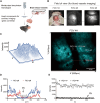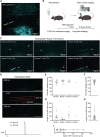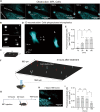Microplastics in the bloodstream can induce cerebral thrombosis by causing cell obstruction and lead to neurobehavioral abnormalities
- PMID: 39841831
- PMCID: PMC11753373
- DOI: 10.1126/sciadv.adr8243
Microplastics in the bloodstream can induce cerebral thrombosis by causing cell obstruction and lead to neurobehavioral abnormalities
Abstract
Human health is being threatened by environmental microplastic (MP) pollution. MPs were detected in the bloodstream and multiple tissues of humans, disrupting the regular physiological processes of organs. Nanoscale plastics can breach the blood-brain barrier, leading to neurotoxic effects. How MPs cause brain functional irregularities remains unclear. This work uses high-depth imaging techniques to investigate the MPs within the brain in vivo. We show that circulating MPs are phagocytosed and lead these cells to obstruction in the capillaries of the brain cortex. These blockages as thrombus formation cause reduced blood flow and neurological abnormalities in mice. Our data reveal a mechanism by which MPs disrupt tissue function indirectly through regulation of cell obstruction and interference with local blood circulation, rather than direct tissue penetration. This revelation offers a lens through which to comprehend the toxicological implications of MPs that invade the bloodstream.
Figures








Similar articles
-
Effects of Microplastic Accumulation on Neuronal Death After Global Cerebral Ischemia.Cells. 2025 Feb 7;14(4):241. doi: 10.3390/cells14040241. Cells. 2025. PMID: 39996714 Free PMC article.
-
Evaluation of Neurotoxicity in BALB/c Mice following Chronic Exposure to Polystyrene Microplastics.Environ Health Perspect. 2022 Oct;130(10):107002. doi: 10.1289/EHP10255. Epub 2022 Oct 12. Environ Health Perspect. 2022. PMID: 36251724 Free PMC article.
-
Neurotoxicities induced by micro/nanoplastics: A review focusing on the risks of neurological diseases.J Hazard Mater. 2024 May 5;469:134054. doi: 10.1016/j.jhazmat.2024.134054. Epub 2024 Mar 15. J Hazard Mater. 2024. PMID: 38503214 Review.
-
Multimodal detection and analysis of microplastics in human thrombi from multiple anatomically distinct sites.EBioMedicine. 2024 May;103:105118. doi: 10.1016/j.ebiom.2024.105118. Epub 2024 Apr 13. EBioMedicine. 2024. PMID: 38614011 Free PMC article.
-
Microplastics and human health: unveiling the gut microbiome disruption and chronic disease risks.Front Cell Infect Microbiol. 2024 Nov 25;14:1492759. doi: 10.3389/fcimb.2024.1492759. eCollection 2024. Front Cell Infect Microbiol. 2024. PMID: 39669275 Free PMC article. Review.
Cited by
-
Characterization of Reusable and Recyclable Plastic Bedding Materials for Laboratory Mice.Animals (Basel). 2025 Feb 10;15(4):501. doi: 10.3390/ani15040501. Animals (Basel). 2025. PMID: 40002982 Free PMC article.
-
Risk Assessment of Microplastics in Humans: Distribution, Exposure, and Toxicological Effects.Polymers (Basel). 2025 Jun 18;17(12):1699. doi: 10.3390/polym17121699. Polymers (Basel). 2025. PMID: 40574225 Free PMC article. Review.
-
Visualizing the internalization and biological impact of nanoplastics in live intestinal organoids by Fluorescence Lifetime Imaging Microscopy (FLIM).Light Sci Appl. 2025 Aug 12;14(1):272. doi: 10.1038/s41377-025-01949-0. Light Sci Appl. 2025. PMID: 40796554 Free PMC article.
-
A Direct Relationship Between 'Blood Stasis' and Fibrinaloid Microclots in Chronic, Inflammatory, and Vascular Diseases, and Some Traditional Natural Products Approaches to Treatment.Pharmaceuticals (Basel). 2025 May 12;18(5):712. doi: 10.3390/ph18050712. Pharmaceuticals (Basel). 2025. PMID: 40430532 Free PMC article. Review.
-
Your brain is full of microplastics: are they harming you?Nature. 2025 Feb;638(8050):311-313. doi: 10.1038/d41586-025-00405-8. Nature. 2025. PMID: 39934326 No abstract available.
References
-
- Banerjee A., Shelver W. L., Micro- and nanoplastic induced cellular toxicity in mammals: A review. Sci. Total Environ. 755, 142518 (2021). - PubMed
-
- Huang W., Song B., Liang J., Niu Q., Zeng G., Shen M., Deng J., Luo Y., Wen X., Zhang Y., Microplastics and associated contaminants in the aquatic environment: A review on their ecotoxicological effects, trophic transfer, and potential impacts to human health. J. Hazard. Mater. 405, 124187 (2021). - PubMed
-
- Law K. L., Narayan R., Reducing environmental plastic pollution by designing polymer materials for managed end-of-life. Nat. Rev. Mater. 7, 104–116 (2022).
-
- Jambeck J. R., Geyer R., Wilcox C., Siegler T. R., Perryman M., Andrady A., Narayan R., Law K. L., Plastic waste inputs from land into the ocean. Science 347, 768–771 (2015). - PubMed
MeSH terms
Substances
LinkOut - more resources
Full Text Sources

